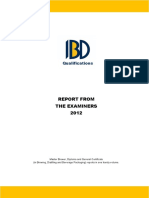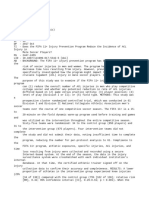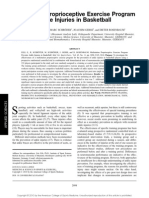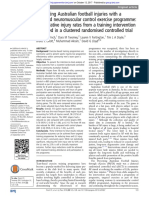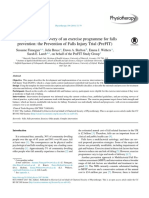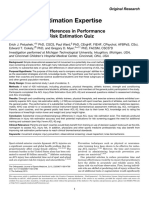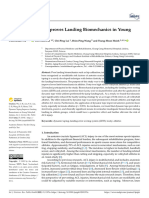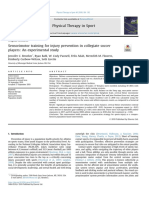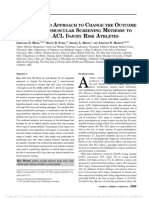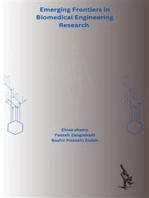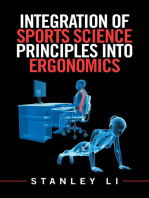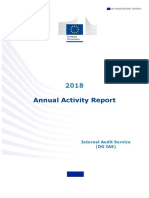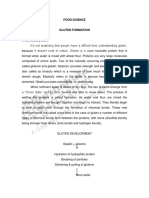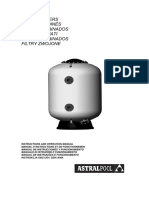Vol.:(0123456789)
Sports Medicine https://doi.org/10.1007/s40279-023-01974-2
SYSTEMATIC REVIEW
Injury Prevention Programmes Fail to Change Most Lower Limb Kinematics and Kinetics in Female Team Field and Court Sports: A Systematic Review and Meta-Analysis of Randomised Controlled Trials
Yuri Lopes Lima
1,2
1,2
3
1,2
1,2
Accepted: 13 November 2023 © The Author(s), under exclusive licence to Springer Nature Switzerland AG 2023
Abstract
Background
One mechanism by which exercise interventions may be effective in reducing anterior cruciate ligament (ACL) injury risk is through changes in lower limb biomechanics. Understanding how training programmes affect lower-limb kin-ematics and kinetics may help refine injury prevention programmes.
Objective
The aim of this systematic review and meta-analysis was to assess the effect of injury prevention programmes on kinematics and kinetics during tasks related to ACL injury in female team field and court sports.
Data Sources
Five databases were searched in October 2022.
Eligibility Criteria
Randomised controlled trials assessing the effect of injury prevention programmes compared with usual training/no training on lower limb kinematics and kinetics in female team field and court sports were eligible for review.
Results
Sixteen studies were included. A total of 976 female athletes were included. Most of the studies included interven-tions with multiple components (12/16). Commonly used components were plyometrics (12/16), strength (8/16), and bal-ance/stability (7/16). Thirteen studies had routine training or sham interventions as the control group and three studies had no training. Very low certainty evidence suggests that injury prevention programmes increase knee flexion angles (mean difference = 3.1° [95% confidence interval 0.8–5.5]); however, very low to low certainty evidence suggests no effect on hip flexion angles/moments, knee flexion moments, hip adduction angles/moments, knee adduction angles/moments, hip internal rotation angles/moments, ankle dorsiflexion angles, and ground reaction forces, compared with usual training/no training.
Conclusion
Injury prevention programmes may be effective in increasing knee flexion angles during dynamic landing and cutting tasks but may have no effect on other lower limb biomechanical variables. As such, the benefits of injury prevention programmes may be mediated by factors other than altered biomechanics and/or may happen through other biomechanical measures not included in this review.
Key Points
Injury prevention programmes may increase knee flexion angles during dynamic landing and cutting tasks relevant to ACL injuries.Injury prevention programmes do not affect other hip, knee, or ankle angles and moments.
*
Yuri Lopes Lima yuri.lopeslima@griffithuni.edu.au
1
School of Health Sciences and Social Work, Clinical Sciences G02, Griffith University, Parklands Drive, Southport, QLD 4215, Australia
2
Griffith Centre of Biomedical and Rehabilitation Engineering (GCORE), Menzies Health Institute Queensland, Griffith University, Southport, Australia
3
Sydney Musculoskeletal Health, Sydney School of Health Sciences, Faculty of Medicine and Health, The University of Sydney, Sydney, Australia
1 Introduction

Y. L. Lima et al.
explanations for higher injury risk in females range from differences in anatomy, hormones, and neuromuscular control to sociocultural and environmental factors such as limited access to facilities, training opportunities, and access to development staff and resources [4]. An ACL rupture is a catastrophic and life-altering injury, resulting in long return to sport times [5], difficulties returning to pre-injury levels of competition [6], high cost of treatment [7, 8], and increased rates of early-onset knee osteoarthri-
tis [9, 10]. To reduce the burden of ACL injury, establish-
ing evidence-based strategies to reduce ACL injury risk in women athletes is a high priority in sports medicine.Previously investigated multimodal injury prevention programmes are effective at reducing the risk of ACL injury in women by 45–67% [11, 12], and are
recommended for use in practice [13]. These programmes often consist of a wide range of exercises in an attempt to target various physical attributes, such as strength, coordination, plyometrics, agility, and fitness programmes [14, 15]. However, the underlying adaptations to training
that are responsible for reducing ACL injury risk are not well understood.The association between an individual’s biomechanics and ACL injury risk has been investigated extensively [16–18]. Players who have a higher risk of injury perform
dynamic tasks (e.g., jumping and cutting manoeuvres) with lower peak hip and knee flexion angles, greater knee abduction angles and moments, and greater vertical ground reaction forces (GRF) compared with players with lower injury risk [19–22], although evidence
between studies is conflicting as similar studies show no association between these measures and injury risk [16, 17, 23, 24]. It is postulated that one mechanism by
which exercise is effective in reducing ACL injury risk is through changes in biomechanics; thus, understanding how exercise affects known or proposed biomechanical risk factors and mechanisms may help refine injury prevention programmes. Previous reviews suggest that injury prevention programmes aim to alter biomechanics (i.e. increase knee flexion angles, decrease knee valgus moments and angles, decrease GRF) to reduce ACL loading and injury risk [25–29], while others showed
inconsistent results [30, 31]. These previous reviews were
either purely narrative [30], included non-randomised intervention studies (no control group) [25, 27, 28, 31],
or included mixed female/male cohorts [26, 29]. The aim
of this study was to systematically review the literature and synthesise the evidence examining the effect of injury prevention programmes on lower limb kinematics and kinetics during tasks relevant to ACL injury in female team field and court sports.
2 Methods
This systematic review was conducted according to the Cochrane Handbook for Systematic Reviews of Interven-tions [32] and is reported according to the Preferred Report-ing Items for Systematic reviews and Meta-Analysis [33] and the PRISMA in Exercise, Rehabilitation, Sports medicine and SporTs science guidance [34]. The protocol was pre-registered in PROSPERO (CRD42022361686).
2.1 Eligibility Criteria
Studies were included if they met the following criteria: (1) included female athletes only, with at least 75% of the sample participating in team field and court sports (sports included, but were not limited to, soccer, basketball, vol-leyball, softball, netball, field hockey; any age or participa-tion level); (2) included an injury prevention programme (any multi- or single-component training programme that involved resistance, plyometric, neuromuscular, and bal-ance components focussed on lower limb outcomes) with a control group exposed to usual training/no training. Pro-grammes solely based on movement retraining or composed of a single training session were not included; (3) reported any objective measure of lower limb kinematics or kinetics assessed during a dynamic task relevant to ACL injury (i.e., jumping, landing, cutting, hopping); and (4) employed a ran-domised controlled trial (RCT) design. Studies published in a language other than English, reviews, editorials, disserta-tions, and conference proceedings were excluded. Studies reporting results from mixed samples (e.g., male and female) were excluded unless female-specific results were reported separately from male data.
2.2 Information Sources and Search Strategy
The following databases were searched from inception to October 20, 2022: PubMed, EMBASE, CINAHL, Scopus, and SPORTDiscus. The search strategy was composed of terms related to injury prevention, exercise types (e.g., plyometric, resistance, neuromuscular, balance), female population, and biomechanical outcome measures. The full search strategy can be found in the electronic supplementary material (ESM), Table S1.
2.3 Article Screening
Article screening was performed using Covidence soft-ware (Veritas Health Information, Melbourne, Australia). Titles and abstracts identified using the search strategy were
The Effect of Injury Prevention Programmes on Biomechanics in Female Athletes
screened by one reviewer for potential inclusion (YL). The full text of potentially eligible studies was retrieved and assessed for inclusion by two reviewers (YL, TC). A third reviewer was available to resolve any conflicts (MB).
2.4 Data Extraction
A piloted form was used to extract the following data from the included studies: participant characteristics (sample size, age, participation level, sport), study design (individually randomised or cluster randomised trial), characteristics of the interventions (components of the intervention, number of sessions, intervention period), outcomes (constructs), task, data collection system, and between-group effect measure (post-intervention scores or change scores). One author extracted the data (YL), and a second author checked the data for extraction errors (TC). If data were not reported, two attempts were made to retrieve required data from the corresponding author. Data were considered irretrievable if we did not receive a response.
2.5 Risk of Bias Assessment
The included studies were assessed for methodological qual-ity using the Cochrane Collaboration Risk of Bias Tool ver-sion 2 [35]. Two reviewers (YL, TC) independently assessed included studies for risk of bias. If any disagreements occurred, a solution was sought via discussion between reviewers. A third reviewer (MB) was available for the final judgement if the disagreement could not be resolved. Risk of bias was assessed according to the domains (i) randomisa-tion process; (ii) deviations from intended interventions; (iii) missing outcome data; (iv) measurement of the outcome; and (v) selection of the reported result.
2.6 Certainty of the Evidence
We used the five Grading of Recommendations Assessment, Development and Evaluation (GRADE) criteria (risk of bias, publication bias, imprecision, inconsistency, and indirectness) to assess the certainty of the evidence. We downgraded the evidence by one level for serious limitations, or by two levels for very serious limitations [36]. Detailed explanations on the specific reasons for downgrading of each criterion can be found in the footnotes of Table 1.
2.7 Synthesis Methods
Studies were summarised by intervention and outcome. To examine the effects of the intervention, the point estimates for the mean difference (MD) between intervention and control groups and standard deviations and sample sizes for each intervention arm were extracted. Change scores or post-treatment scores (for studies with more than one follow-up timepoint, the most immediate time point after conclusion of training was considered), standard deviations, and sample sizes were retrieved to calculate the point estimates and 95% confidence intervals (CI) of the intervention effect sizes. Change scores and post-treatment scores were combined in the same meta-analyses, as the difference in mean post-intervention scores and mean change scores will, on average, be the same [32]. Post-treatment scores were retrieved when change scores were not available. Relevant outcomes extracted for meta-analysis included hip, knee, and ankle angles, hip and knee moments, and vertical GRFs. Sign conventions were inconsistent among included studies, and therefore were standardised as follows: positive values for hip flexion, knee flexion, ankle dorsiflexion, hip adduction, knee adduction, and hip internal rotation
angles
, and hip flexion, knee flexion, ankle dorsiflexion, hip adduction, knee adduction, and hip internal rotation
moments
. Phases of interest included discrete values at initial foot contact or peak values. Joint moments are reported as external moments.Studies deemed methodologically homogeneous were pooled for meta-analysis if (i) the intervention arm had at least one component of exercise (i.e., strength, plyomet-rics, stability, etc.), (ii) the control arm had usual training/ no training, and (iii) the angles were measured in degrees and the moments were measured in Newton-metres or New-ton-metres/kg. When studies reported standard errors, the standard deviations were computed following recommenda-tions [32]. For angle measures, the MD in degrees was used, for moments and ground reaction force (GRF) measures, the standardised mean difference (SMD) was used. Due to variation in sports, tasks, and age, a random-effects model meta-analysis was used to account for heterogeneity. Where outcomes were measured during multiple tasks in the same study (e.g., double-leg landing and single-leg landing), a three-level meta-analysis was used by nesting the studies as a random factor in the model to account for dependency of point estimates. Subgroup analyses were performed to test the moderating effect of different types of tasks (single- or double-leg), control group (no training or usual training), and data collection system (three-dimensional or two-dimen-sional). All analyses were conducted in R Studio (version 2022.07.2, Boston, USA) using the
meta
and
metacont
I
2
statistic, which describes the per-centage of the variability in effect estimates that is due to
Y. L. Lima et al.
Table 1
Grades of Recommendation, Assessment, Development and Evaluation (GRADE) quality of evidenceGRADE Working Group grades of evidenceHigh certainty: we are very confident that the true effect lies close to that of the estimate of the effectModerate certainty: we are moderately confident in the effect estimate: the true effect is likely to be close to the estimate of the effect, but there is a possibility that it is substantially differentLow certainty: our confidence in the effect estimate is limited: the true effect may be substantially different from the estimate of the effectVery low certainty: we have very little confidence in the effect estimate: the true effect is likely to be substantially different from the estimate of effect
CI
confidence interval,
MD
mean difference,
RCT
randomised controlled trial,
SMD
standardised mean difference
a
Downgraded due to majority of studies considered as having 'high risk of bias' or 'some concerns'
b
Downgraded due to total sample size being < 800
c
Downgraded due to
I
2
statistic > 40%
OutcomesRisk of biasInconsistencyIndirectnessImprecisionPublication biasDifference (95% CI)No of partici-pants (studies)Certainty of the evidence (GRADE)Hip flexion angle follow-up: range 6–8 weeksSerious
a
Not seriousNot seriousSerious
b
Not seriousMD 0.7°(− 0.5 to 1.9)188(5 RCTs)⨁⨁◯◯Low
a,b
Knee flexion anglefollow-up: range 4–16 weeksSerious
a
Serious
c
Not seriousSerious
b
Not seriousMD 3.1°(0.8 to 5.5)398(10 RCTs)⨁◯◯◯Very low
a,b,c
Hip adduction anglefollow-up: mean 6 weeksSerious
a
Not seriousNot seriousSerious
b
Not seriousMD − 0.4°(− 1.5 to 0.7)159(4 RCTs)⨁⨁◯◯Low
a,b
Knee adduction anglefollow-up: range 4–16 weeksSerious
a
Serious
c
Not seriousSerious
b
Not seriousMD − 0.2°(− 1.6 to 1.2)385(9 RCTs)⨁◯◯◯Very low
a,b,c
Hip flexion momentfollow-up: mean 6 weeksSerious
a
Not seriousNot seriousSerious
b
Not seriousSMD − 0.16 SD(− 0.73 to 0.42)136(3 RCTs)⨁⨁◯◯Low
a,b
Knee flexion momentfollow-up: range 6–8 weeksSerious
a
Not seriousNot seriousSerious
b
Not seriousSMD − 0.17 SD(− 0.35 to 0)158(4 RCTs)⨁⨁◯◯Low
a,b
Knee adduction momentfollow-up: range 6–10 weeksSerious
a
Not seriousNot seriousSerious
b
Not seriousSMD 0.06 SD(− 0.06 to 0.17)528(5 RCTs)⨁⨁◯◯Low
a,b
Hip adduction momentfollow-up: mean 6 weeksSerious
a
Not seriousNot seriousSerious
b
Not seriousSMD − 0.06 SD(− 0.38 to 0.27)136(3 RCTs)⨁⨁◯◯Low
a,b
Ankle dorsiflexion anglefollow-up: mean 6 weeksSerious
a
Not seriousNot seriousVery serious
b
Not seriousMD 7.8°(− 0.5 to 16)16(1 RCT)⨁◯◯◯Very low
a,b
Hip internal rota-tion anglefollow-up: mean 6 weeksSerious
a
Not seriousNot seriousSerious
b
Not seriousMD − 3.8°(− 9.9 to 2.3)136(3 RCTs)⨁⨁◯◯Low
a,b
Hip internal rota-tion momentfollow-up: range 6–10 weeksSerious
a
Serious
c
Not seriousSerious
b
Not seriousSMD 0.01 SD(− 0.55 to 0.56)483(3 RCTs)⨁◯◯◯Very low
a,b,c
Ground reaction forcefollow-up: range 4–7 weeksSerious
a
Serious
c
Not seriousSerious
b
Not seriousSMD − 0.4 SD(− 1.0 to 0.2)130(6 RCTs)⨁◯◯◯Very low
a,b,c






